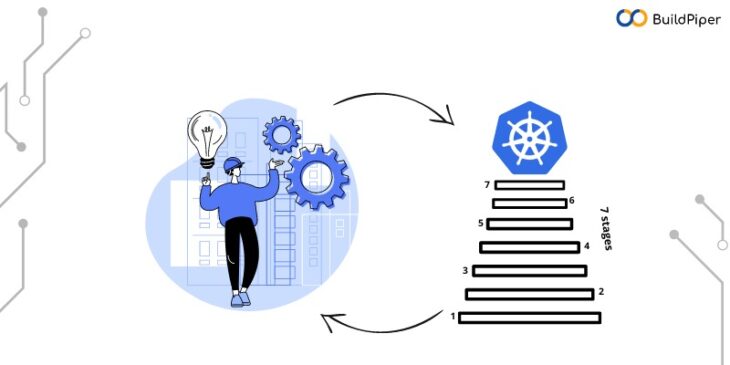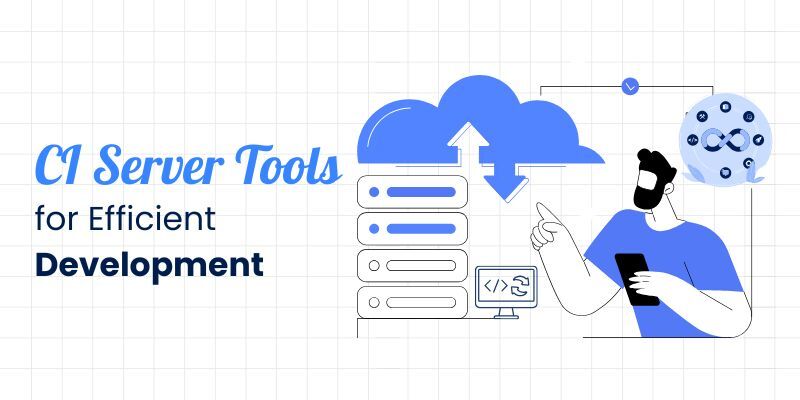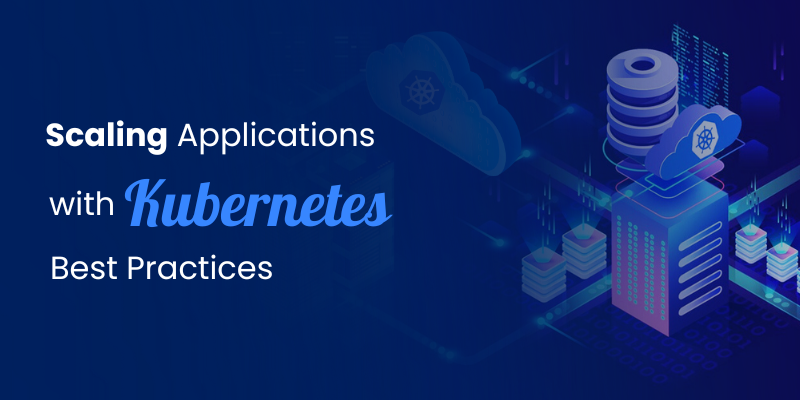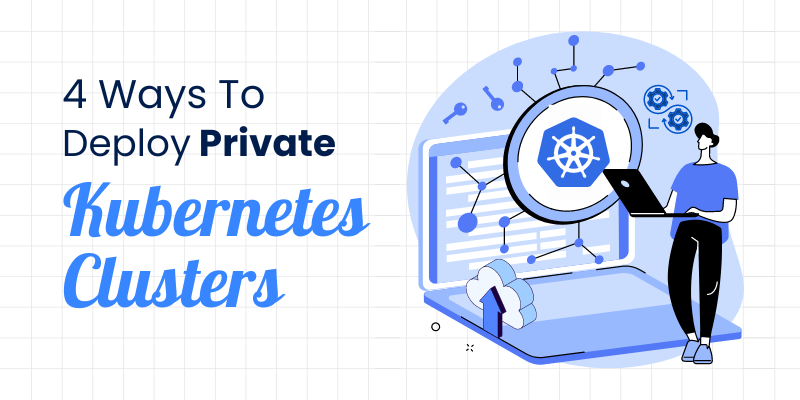
Kubernetes has become the new standard for container orchestration. But, along with the phenomenal benefits of Kubernetes, deploying and managing Kubernetes brings its own set of challenges for enterprises and DevOps teams planning to embrace Kubernetes architecture.
The Kubernetes maturity model is a unique approach to understanding where your enterprise currently stands on the Kubernetes adoption curve and knowing how businesses can get to where they want to be. This maturity model helps organizations understand and meet challenges that may arise when adopting Kubernetes.
So, here are the 7 stages of the Kubernetes maturity model. Let’s take a look!
What is Kubernetes Maturity Model?
The Kubernetes Maturity Model examines the entire Kubernetes journey, identifying each of the seven phases that a business has to go through, along with the skills that DevOps teams need to learn and acquire for enforcing security policies, improving reliability and maximizing efficiency.
The basic goal is to help enterprises identify which stage of the Kubernetes maturity model their businesses are in, understand gaps in embracing Kubernetes, know about the security challenges within their business environment and gain insights into enhancing and improving the Kubernetes stack.
The Basic Purpose!
Kubernetes Maturity Model helps businesses to understand the important aspects their teams need to focus on, when & how should they seek assistance and what are the next steps they should take for enabling a hassle-free Kubernetes deployment.
The Kubernetes Maturity Model serves a distinct purpose for a different set of people. Here’s how.
- Engineers can use the Kubernetes maturity model as a step-by-step and how-to guide.
- Technical Strategists can use this model to identify Kubernetes deployment challenges and set desired expectations.
- Business Leaders can use it to specify organisational goals and measure outcomes that can improve the bottom growth.
[You may also Read: 3 Best Tools to Manage Your Kubernetes Cluster!]
7 Stages of the Kubernetes Maturity Model!
Here’s a brief overview of each phase of the Kubernetes Maturity Model.
Stage 1: Prepare
During this phase of the Kubernetes Maturity Model, teams need to decide and analyse what benefits can Kubernetes bring to your business, know much will it cost to make the shift to embrace Kubernetes architecture, and devise a strategy to understand how and what enterprises intend to achieve.
Stage 2: Transform
During this phase of the Kubernetes Maturity model, enterprises will get started on their Kubernetes journey by setting up the Kubernetes infrastructure. Teams will learn to know and understand how they can migrate workloads to the platform. It is this phase during which the DevOps teams become familiar with Kubernetes and how they can use the benefits of Kubernetes for their infrastructure. Accordingly, they plan a strategy to map and migrate existing technologies to a Kubernetes architecture in a secured and compliant manner.
Stage 3: Deploy
After getting a clear understanding of the basic Kubernetes concepts and how they’ll be applied, DevOps teams will practice and apply these fundamental concepts by introducing the development and deployment process. The teams will implement the build and deploy process via CI/CD(Continuous Integration/Continuous Deployment) pipelines and developers to get the updated status of the cluster with added features of observability and monitoring.
Stage 4: Build Confidence
This phase is the middle of the Kubernetes Maturity Model during which teams need to build confidence in their core competency to deploy and ship features successfully. With a deep understanding of Kubernetes architecture, DevOps teams are all set and ready, to begin with, Kubernetes deployment. During this phase, teams can customize products as per their business requirements and experiment with its features. In phase three, Kubernetes infrastructure is up and running and phase four is where teams start to understand the different variations of adopting Kubernetes and begin using monitoring tools.
Stage 5: Improve Operations
In this stage of the Kubernetes Maturity Model, DevOps & product teams can actively deploy Kubernetes across their business infrastructure. During this phase, teams should begin working on improving security, efficiency and reliability by spending time analyzing Kubernetes cluster configuration. Kubernetes adoption challenges may sometimes be more complex, requiring expertise in deploying and managing Kubernetes.
Stage 6: Measure & Control
This is the phase during which the DevOps & SRE teams bring in security and access controls. Teams make use of state-of-the-art monitoring and altering practices to develop security policies for the existing workload. New policies related to the behaviours, security, configuration and standards are being created. Network policy, workload identity and service mesh are being explored in order to bring in security restrictions on workload. Moreover, teams are in the stage of building a functional understanding of Kubernetes and how things should be done within clusters and the overall environment. Data gathered through the monitoring and observability tools introduced in the previous stages help in understanding what to measure and how to track & control Kubernetes.
Stage 7: Optimize & Automate
In this final phase of the Kubernetes Maturity Model, teams employ and use automated tools to eliminate human errors and efforts to improve reliability and maximize productivity. Teams can also enforce compliance via policy-driven configuration validation of containers and Kubernetes. Configuration validation enables teams to know and determine whether the new systems in the existing business landscape are configured consistently and in accordance with the requirements of the business infrastructure.
Journey to Kubernetes Made Easy with BuildPiper!
Last but not the least, it’s important to remember that a Kubernetes maturity model doesn’t ensure improvement or growth in business. It’s only a way to measure and determine where an organization is in the process of embracing Kubernetes. Enterprises adopting cloud-native technologies need to go through a transformative process that takes time and involves huge costs and extraordinary technical expertise.
Due to the ephemeral and constantly-changing nature of Kubernetes, businesses need a Kubernetes monitoring solution for managing Kubernetes. A platform that has the ability to identify changes automatically and continually monitor events, logs, pod health status, and much more without interruption.
BuildPiper is one such reliable and powerful Kubernetes management platform! It has a Service Overview Dashboard that allows DevOps teams to view and monitor the build and deploy details and a Service Kubernetes Dashboard, that provides out-of-the-box microservice and cluster observability capabilities allowing users to view and monitor the performance, health status, CPU and memory allocation, node availability, logs, and other important metrics.
With BuildPiper, your DevOps team becomes equipped with an end-to-end Kubernetes & Microservices Application Delivery Platform to seamlessly onboard and securely manage Kubernetes & Microservices application setup and deployments along with the ability to run zero-touch, fully-automated & secured CI/CD pipelines.
Discuss “Managed Kubernetes”, one of the core features of BuildPiper with our experts to solve major Kubernetes adoption challenges for your business! Schedule a DEMO NOW!



